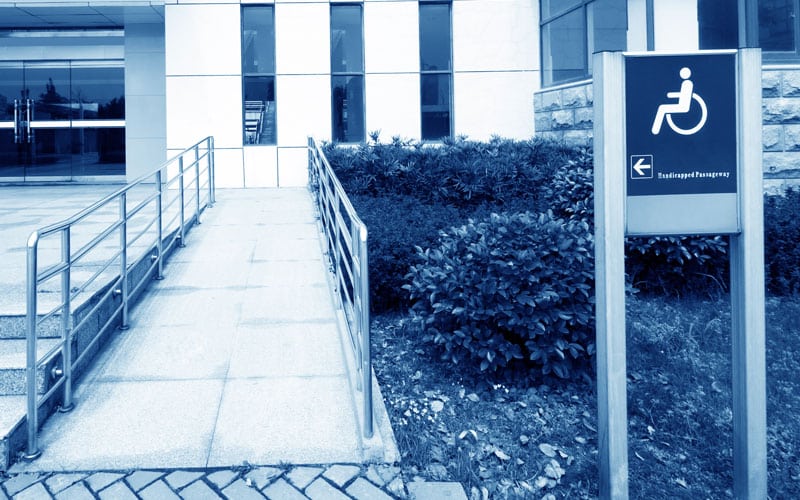Keeping your commercial property or residence within ADA-compliant guidelines is a must for any business. Sidewalks, patios, parking lots, and steps are all included in the required structures that must be kept free of the hazards of uneven concrete.
Understanding the Purpose of ADA Compliance
ADA compliance refers to adherence to the Americans with Disabilities Act (ADA), a federal law enacted to ensure equal access and opportunities for individuals with disabilities. The ADA sets standards for accessibility in various areas, including public accommodations, commercial facilities, transportation, and state and local government services. It impacts a wide range of entities, including businesses, government agencies, property owners, architects, and construction companies.
Uneven concrete surfaces, such as sidewalks, curb ramps, ramp landings, and handrails, play a crucial role in ADA compliance as they directly affect accessibility for individuals with disabilities.
Here’s an overview of how ADA compliance impacts these elements:
ADA Compliant Concrete Sidewalks
Keeping your sidewalks safe is important for all visitors on your commercial property. ADA guidelines state that there can not be more than a quarter-inch in vertical height between sections of the sidewalk. That standard will reduce the potential of tripping while also adding uniformity to your property. Joints are the most common areas that need to be addressed.
ADA-compliant sidewalks are especially important for any visitors who use wheelchairs. ADA guidelines state that sidewalks must be three feet as a minimum. Sidewalks less than five feet wide require passing areas every 200 feet. Passing areas must be sixty inches square.
ADA Compliant Curb Ramps
Curb ramps are required to have a slope of 1:12 ratio. Although there are no ADA requirements on the material used for curb ramps, there is a requirement for the ramp to be slip-resistant and not pool water. With continued use and wear, along with Houston’s moisture, pooling often becomes a problem over time, and ramps are prone to settling after installation, so regular inspection is highly recommended.
ADA Compliant Ramp Landings
Curb ramps must have a landing at the top and bottom of the curb ramp. Additional compliance regulations include:
- All ramps must be level
- The landing must be as wide as the ramp with a minimum width of 60 inches
ADA Compliant Handrails
Handrails are required on all curb ramps with a rise of more than six inches and are required on both sides of the ramp.
Potential Penalties for Not Being ADA Compliant
Failure to comply with ADA regulations can result in legal action, fines, and remediation requirements. The Department of Justice (DOJ) is responsible for enforcing ADA compliance and has the authority to investigate complaints and initiate legal proceedings against non-compliant entities. Depending on the severity and nature of the violation, penalties may include monetary fines, legal fees, and court-ordered remediation to bring the property into compliance with ADA standards.
Additionally, non-compliance with ADA regulations can damage the reputation of businesses and organizations, resulting in loss of customers, negative publicity, and potential legal liability. It’s essential for businesses, property owners, and entities subject to ADA regulations to proactively ensure compliance to avoid the risk of penalties and legal consequences.
Let Us Help You Maintain ADA Compliance
ADA compliance plays a crucial role in promoting inclusivity and ensuring equal access for individuals with disabilities. By adhering to ADA standards and addressing issues such as uneven concrete surfaces, property owners and entities can create environments that are accessible and welcoming to everyone, regardless of their abilities.
Concrete sidewalks, patios, stairs, and curb ramps are used in many variations on commercial properties. Broken, cracked, and uneven concrete can create tripping hazards that are dangerous to those who may require assistance navigating your property. Replacing uneven concrete is often unnecessary, not to mention extremely cost-prohibitive. Let us help you level your concrete and stay ADA-compliant.
Contact Us for a Free Inspection to See if Your Uneven Concrete Is ADA Compliant
If you have uneven concrete and need to bring your home or business within ADA-compliant guidelines, give us a call, and we can schedule a free inspection to help walk you through your options.
Our Service Area
Our outstanding team is ready to provide expert assistance for all your concrete leveling projects in Houston, TX, and the surrounding counties within the Greater Houston region, including:
- Harris County, TX
- Fort Bend County, TX
- Galveston County, TX
- Chambers County, TX
- Liberty County, TX
- Montgomery County, TX
- Brazoria County, TX
- Waller County, TX
- Auston County, TX

